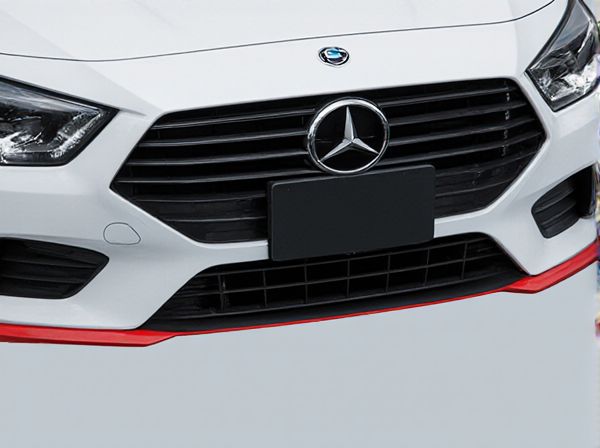
Photo illustration: Euro bumper vs US bumper
Euro bumpers are typically narrower, designed for better aerodynamics and often feature slimmer, integrated lighting elements, while US bumpers are larger, built to meet stringent safety regulations and include robust impact-absorbing materials. You'll notice Euro bumpers prioritize style and efficiency, whereas US bumpers focus more on protection and compliance with federal collision standards. The differences impact vehicle aesthetics, weight, and sometimes repair costs, depending on the market.
Table of Comparison
| Feature | Euro Bumper | US Bumper |
|---|---|---|
| Regulation Standard | ECE Regulation (Europe) | FMVSS bumper standards (USA) |
| Impact Resistance | Low speed impact up to 4 km/h | Low speed impact up to 8 km/h |
| Height Requirements | Lower mounting height (usually 400-550 mm) | Higher mounting height (usually 510-610 mm) |
| Material Composition | Lightweight plastic with energy absorbers | Heavier metal reinforcements + plastic cover |
| Design Focus | Pedestrian safety and aesthetics | Crash absorption and occupant protection |
| Cost Impact | Lower production cost | Higher production cost |
| Compatibility | Compatible with European vehicle designs | Meets US vehicle safety regulations |
Introduction to Euro and US Bumpers
Euro bumpers are designed with a focus on sleek aesthetics and minimalistic styling, often featuring slimmer profiles and integrated lighting elements to meet European safety regulations. US bumpers prioritize robustness and impact absorption, typically incorporating larger, more protruding structures to comply with stringent federal crash standards and pedestrian safety rules. Material composition also varies, with Euro bumpers commonly utilizing lightweight plastics and composites, while US bumpers often combine steel reinforcements with plastic covers for enhanced durability.
Key Design Differences
Euro bumpers typically feature a sleeker, more integrated design with smoother lines that align closely with the vehicle's body, often incorporating thinner materials and less protrusion to meet European pedestrian safety standards. In contrast, US bumpers are generally bulkier and more robust, designed to withstand low-speed impacts without damage, adhering to stricter federal safety regulations like the 5 mph impact standard. The key design differences arise from varying regulatory requirements, resulting in Euro bumpers prioritizing aesthetics and pedestrian protection, while US bumpers emphasize durability and impact resistance.
Regulatory Standards Comparison
Euro bumpers comply with strict European Union regulations such as UNECE Regulation 42, which mandates specific impact absorption and height requirements to enhance pedestrian safety. US bumpers adhere to Federal Motor Vehicle Safety Standard (FMVSS) 581, focusing on protecting vehicle structures during low-speed impacts without stringent pedestrian protection rules. Differences in crash test protocols and material standards result in distinct design priorities, with Euro bumpers favoring energy absorption and pedestrian impact mitigation, while US bumpers emphasize damage minimization in parking-speed collisions.
Material and Construction Variations
Euro bumpers typically use a combination of flexible thermoplastic materials such as polypropylene, which provide lightweight durability and enhanced impact absorption. US bumpers often feature heavier steel or aluminum reinforcements behind plastic covers to meet stricter federal safety regulations and higher impact standards. Construction variations reflect regional safety priorities, with Euro bumpers emphasizing pedestrian protection and US bumpers focusing on crash resistance.
Safety Requirements: Europe vs United States
Euro bumpers adhere to the European Union's stringent pedestrian safety regulations, featuring energy-absorbing materials designed to minimize injury in low-speed collisions, with specific impact test zones defined under UNECE Regulation 42. US bumpers comply with Federal Motor Vehicle Safety Standard (FMVSS) 581, emphasizing damage resistance at 2.5 mph front and 2 mph rear impacts to protect vehicle structures rather than pedestrian safety. The EU mandates pedestrian impact tests focusing on reducing leg and head injuries, whereas US regulations prioritize vehicle repair cost reduction and occupant safety, reflecting divergent safety priorities between the two regions.
Aesthetics and Styling Impact
Euro bumpers typically exhibit a slimmer and more integrated design, enhancing the vehicle's sleek and streamlined appearance. US bumpers are often larger and more prominent due to stricter safety regulations, resulting in a bulkier look that can disrupt the vehicle's overall aesthetics. The minimalist styling of Euro bumpers appeals to enthusiasts seeking a sportier and more refined visual impact compared to the utilitarian emphasis of US bumpers.
Compatibility and Fitment Issues
Euro bumpers often differ from US bumpers in shape, size, and mounting points, leading to compatibility challenges when swapping parts between models. US bumpers typically include additional reinforcements and impact-absorbing components to meet stricter safety regulations, which can affect fitment on vehicles designed for Euro bumpers. Modifying mounting brackets or custom fabrication is frequently necessary to ensure proper alignment and secure installation when attempting cross-market bumper replacements.
Cost and Availability
Euro bumpers typically cost more than US bumpers due to stricter European safety regulations and higher-quality materials used in their manufacturing. Availability of Euro bumpers is often limited outside Europe, resulting in higher shipping and import fees for international buyers. US bumpers are widely available in North America, generally more affordable, and easier to replace due to a larger aftermarket and standardized designs.
Performance in Crash Tests
Euro bumpers demonstrate superior performance in crash tests due to stringent European safety regulations, emphasizing energy absorption and pedestrian protection. US bumpers prioritize impact durability, often resulting in heavier designs that can increase vehicle weight and affect fuel efficiency. Studies show Euro bumpers reduce injury severity in low-speed collisions more effectively compared to their US counterparts.
Choosing the Right Bumper for Your Vehicle
Choosing the right bumper for your vehicle depends on regional safety standards and design preferences, with Euro bumpers typically designed to meet stringent pedestrian safety regulations and US bumpers emphasizing impact resistance under federal crash tests. Euro bumpers are often slimmer with integrated sensors and improved energy absorption to reduce injury severity, while US bumpers are bulkier and built to withstand higher-speed collisions. Understanding these differences ensures proper fit, compliance with local laws, and enhanced vehicle protection tailored to driving environments.
 caratoz.com
caratoz.com